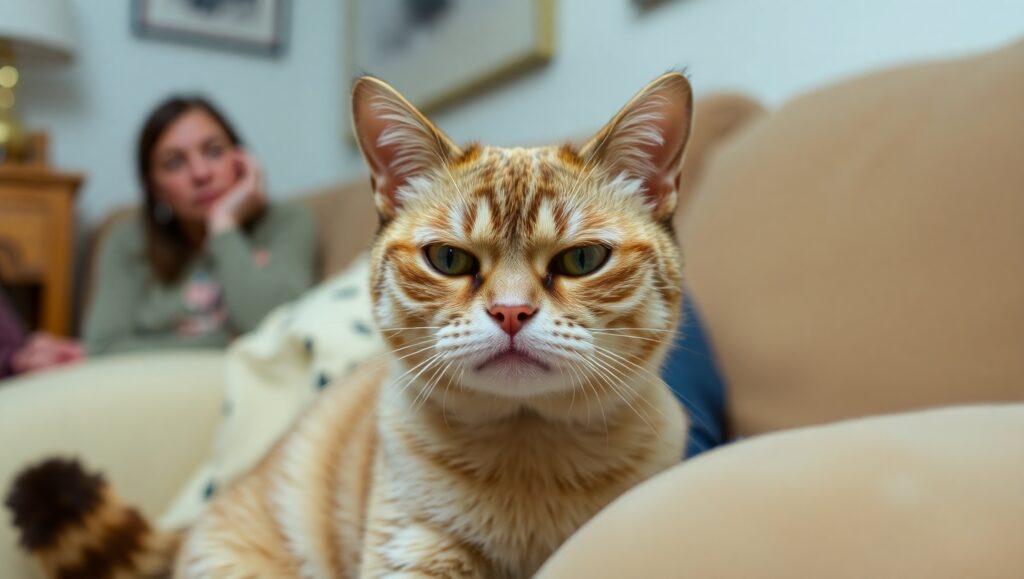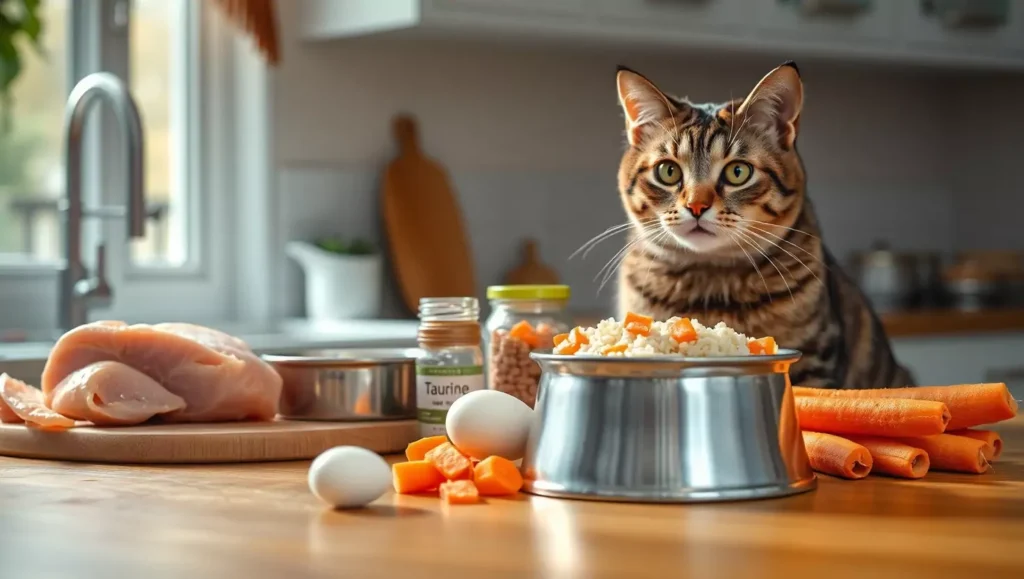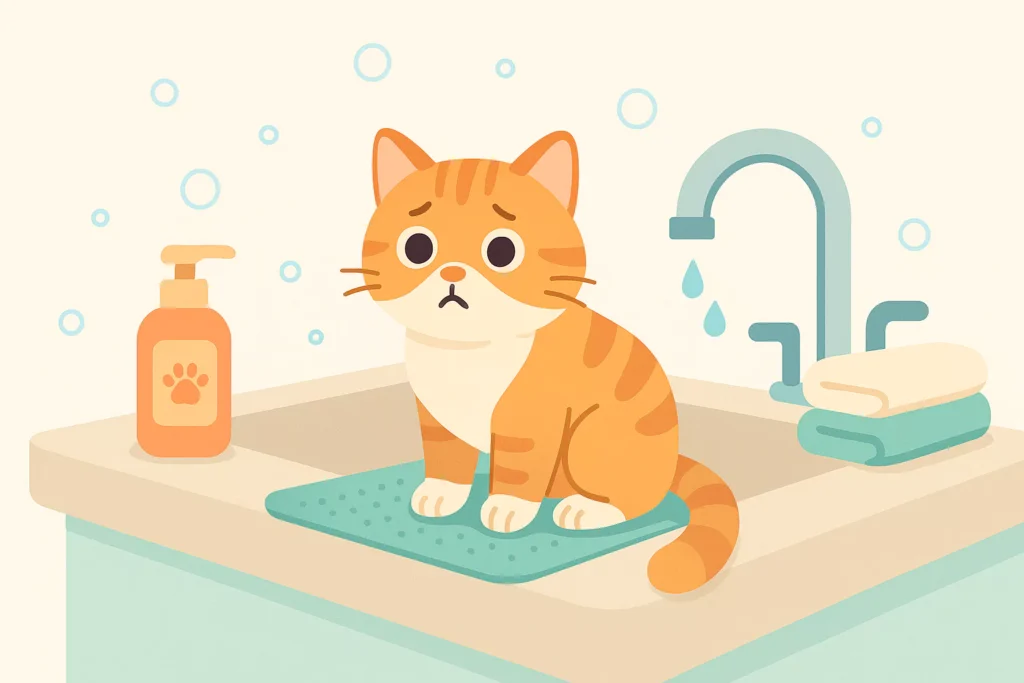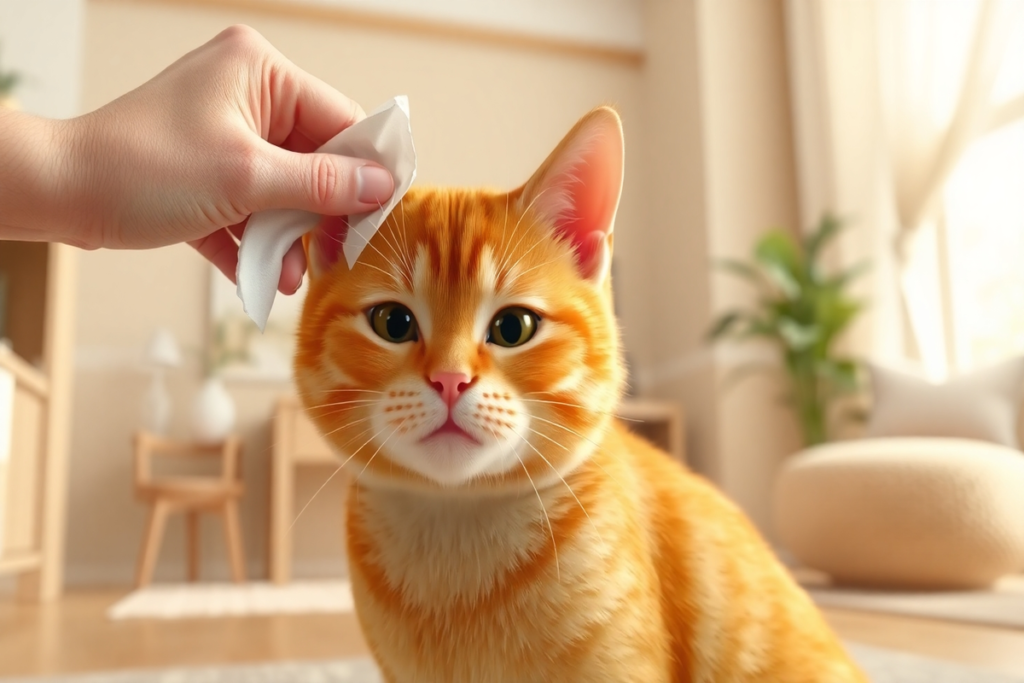Is your cat meowing non-stop, missing meals, or having strange mood swings? The problem could not necessarily be in the food, but in the lack of a proper cat feeding schedule.
A well-regulated feeding schedule does much more than fill your kitty’s belly; it ensures your cat’s health, stable energy levels, mood balance, and good behaviour. Like humans, cats need a routine. Whether you’re a new cat owner or tweaking a current routine, understanding the perfect cat feeding guide is essential for your cat’s well-being.
In this comprehensive guide, you’ll find vet-approved feeding times for kittens, adults, and seniors, along with custom schedules, portion control tips, the best feeding methods (free feeding, meal feeding, or combo feeding), and common mistakes to avoid, ensuring a hassle-free experience.
Let’s dive in and make mealtime one of the healthiest habits in your cat’s day.
Why a Feeding Schedule Matters for Cats
Cats are creatures of habit, and their physical and emotional health depends on consistent behaviors. Wildcats may catch small prey multiple times a day. Still, domesticated cats rely entirely on humans to feed them, and any irregularity in consistency may cause a health and behavior issue for your cat.
Below are some reasons a feeding routine is a necessity, not an optional convenience.
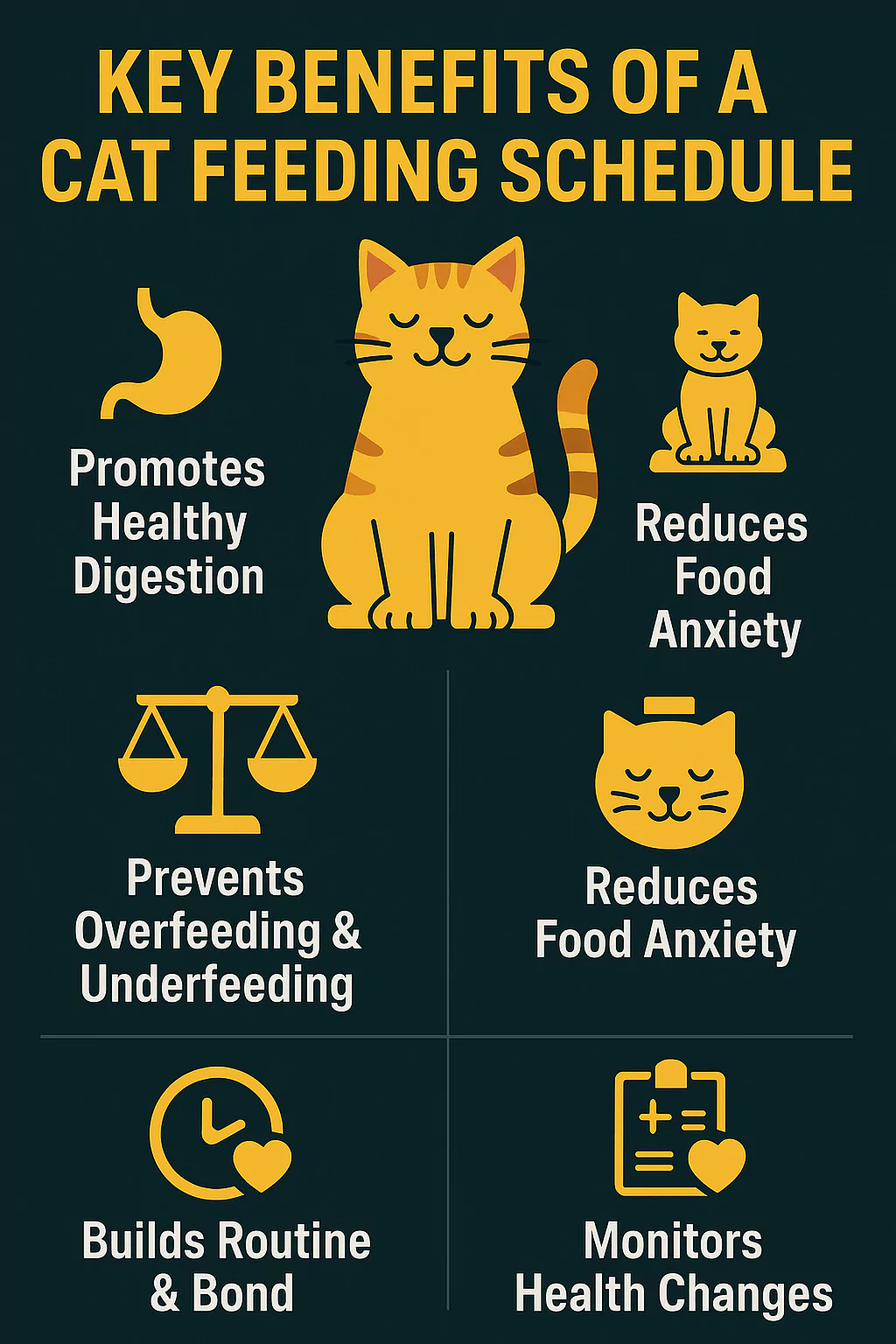
Encourages Healthy Digestion
Maintaining a consistent feeding schedule improves digestion, facilitates nutrient absorption, and reduces the likelihood of bloating, vomiting, or diarrhea. For senior cats or cats with sensitive stomachs, consistent feeding times are comforting and lessen the effects of digestive upset.
Moreover, feeding your cat irregularly or providing larger or less frequent meals is not beneficial for your cat’s digestive system and can lead to discomfort or health issues. A routine helps maintain digestion in balance and supports cats’ long-term health.
Prevents Overeating or Underfeeding
The process of feeding your cat at specific times and with particular amounts helps track calorie intake, thereby inhibiting obesity or malnourishment. Free-feeding can often lead to boredom eating and weight gain, while giving your cat too much, not enough, or uneven portions can contribute to inadequate nutrition. Having a set schedule can establish balanced cat nutrition, reduce the need for treats, and eliminate the need for human food.
It will also allow your cat to feel secure, reduce anxiety, and support positive behavior. It also reinforces consistency in how much your cat eats each day and reduces the chance that your cat will overfeed due to boredom. It is common for cats that are free fed (given access to food all day long) to overeat, especially if they are not active indoor cats.
If your cat shows unusual eating behaviors or energy levels, it may signal illness. Knowing how often to take your cat to the vet ensures health issues are caught before they become serious.
Helps Detect Health Issues Early
Consistency with feedings will help you better observe your cat’s eating habits. Appetite changes, whether eating less than usual, skipping meals, or not eating at all, can all be early signs of possible health issues, such as:
- Dental pain (not being able to chew)
- Gastrointestinal distress (vomiting, constipation, diarrhea)
- Chronic illness (such as diabetes, kidney disease, hyperthyroidism)
Scheduled feeding illustrates these changes even quickly. When your cat misses a meal or eats significantly less, that’s a sign something might be wrong, allowing you to seek veterinary assistance sooner. Free-feeding complicates tracking food intake, often delaying the detection of serious problems.
Reduces Food-Related Anxiety and Begging
Cats want stability and feel the most comfortable when they know what to expect. When your cat learns to expect food at regular intervals (e.g., 8 AM and 6 PM), they stop worrying about the next meal. Predictability reduces stress around food. If your cat still seems restless, explore methods on how to calm an anxious cat to ease food-related anxiety.
Fixed mealtimes create a sense of security and help mitigate:
- Anxiety around food availability
- Non-stop meowing, pacing, or pawing at the food bowl.
- Begging at night or waking you up too early
Scheduled Feeding vs. Free Feeding: Which Is Best for Your Cat?
While giving your cat food may seem as easy as filling a bowl, the feeding methods you choose to feed your cat can impact their health, behavior, and overall well-being. The two most common feeding methods are scheduled feeding (also known as meal feeding) and free feeding (also referred to as grazing). These methods have their benefits and will depend on your cat’s lifestyle and health needs, as well as your schedule.
If you are a new pet parent, establishing a routine is one of the most critical factors. Learn more about cat care tips for beginners to follow to ensure a healthy and happy cat.
Let’s explore both in detail so you can make the best decision for your feline friend.
Cat Feeding Methods Comparison Table
| Feature | Scheduled Feeding | Free Feeding |
| What It Is | Set mealtimes with fixed proportion | Dry food out all day |
| Best For | Weight control, wet food, multi-cats | Busy owners, kittens, skinny cats |
| Portion Control | Easy to track and adjust | Hard to monitor |
| Weight Management | Helps maintain healthy weight | Risk of overeating |
| Monitoring Health | Appetite changes noticed easily | Signs may go unseen |
| Routine & Discipline | Builds good habits | May cause food fussiness |
| Convenience | Needs routine or auto-feeder | Great for busy days |
| Food Type | Suits wet/mixed diets | Only dry kibble |
| Drawbacks | Needs time or device | Risk of weight gain, less control |
Which Method Should You Choose?
While both methods of feeding have their advantages, scheduled feeding is often the best option for most indoor cats, especially those with a tendency to gain weight, anxiety, or digestive issues. It gives you more control and helps you identify health issues more quickly, while also providing your cat with a healthy rhythm each day.
Free feeding can be a suitable option for kittens, underweight cats, or multiple-cat homes where it is challenging to feed cats on a schedule; however, it is essential to monitor them closely to prevent overeating.
In most cases, scheduled meals are a healthier and safer option, particularly when:
- You are feeding wet or mixed food
- You want to monitor your cat’s weight or health
- You want to add some structure to your cat’s day
Feeding Frequency by Life Stage
A cat’s nutritional needs and feeding frequency vary greatly throughout their life. If you feed a kitten like an adult or an older cat like a kitten, it could lead to malnourishment, weight issues, or digestive distress. Understanding and adapting your cat’s feeding schedule can help support healthy development, weight, and overall health as they age.
Kitten Feeding Schedule (0–12 Months)
Kittens are bundles of energy and grow rapidly. They have small stomachs and can’t eat too much food at once, so they require several meals a day, in small portions.
Select a high-protein, high-fat kitten food that is specifically formulated to meet their higher energy requirements. These formulas contain essential nutrients, such as DHA and taurine, to facilitate healthy brain and eye development.
- 0-6 Months: Feed your kitten four meals a day; this consistent intake will support their growth, including muscle development, eye development, bone growth, and immune health.
- 6-12 Months: Begin switching to three meals a day as they start slowing down their growth and are prepared to transition to adult feeding schedules.
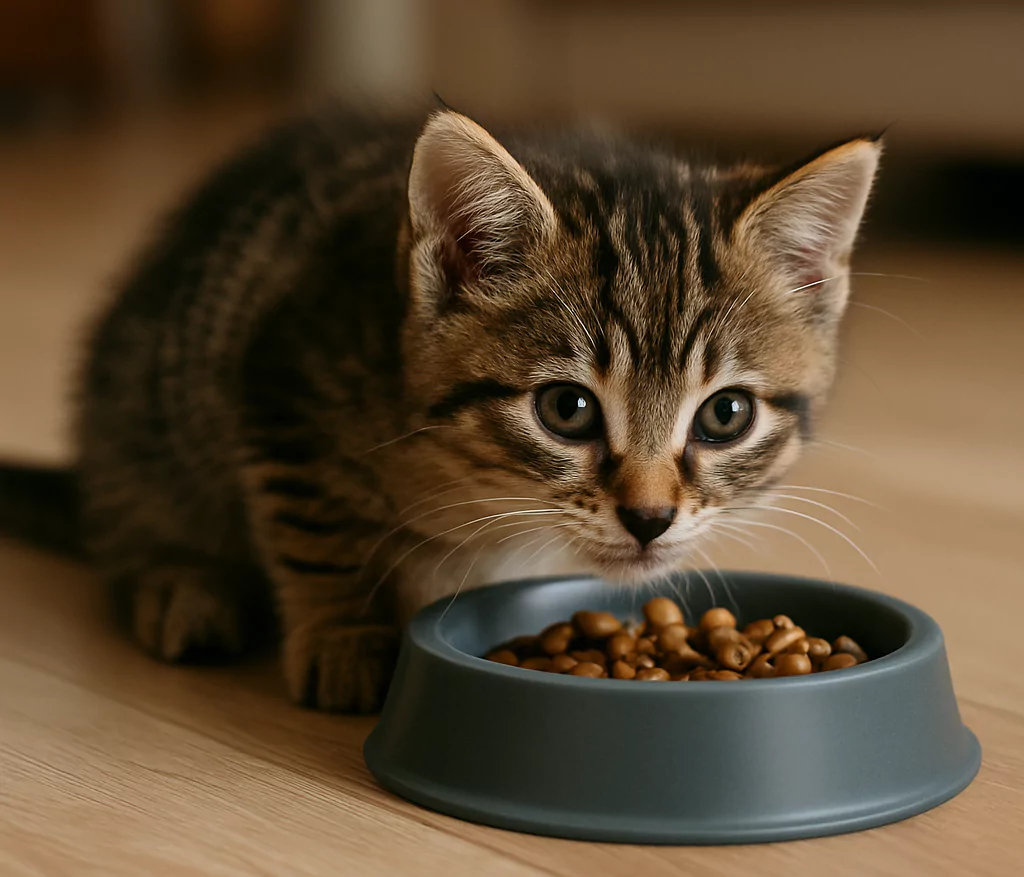
Suggested Schedule:
- 7:00 AM – Breakfast
- 12:00 PM – Middle Meal
- 5:00 PM – Evening Meal
- 9:00 PM – Light Snack
Avoid feeding adult cat food, as it does not have the calorie density or nutritional balance to meet the cold-weather requirements of this stage of growth.
Adult Cat Feeding Routine (1–7 Years)
When a cat reaches 12 months of age, it is considered an adult cat. At this point in their development, their growth slows and their energy needs change, which will impact their routine eating habits to promote a balanced, healthy lifestyle.
Feeding their meals, spaced about 8-12 hours apart, is ideal for sustaining digestion and metabolism, and helps with overeating or constant begging. This 8-12 hours apart schedule mimics natural feeding patterns and works well for most households.
Most adult cats will do best with two meals per day:
- A morning meal of around 7:00 AM – Serve ½ of the daily food portion (wet or dry)
- An evening meal of around 6:00 PM – Serve the remaining ½ portion.
This routine works well even for finicky eaters, as the predictable schedule helps stimulate appetite at meal times.
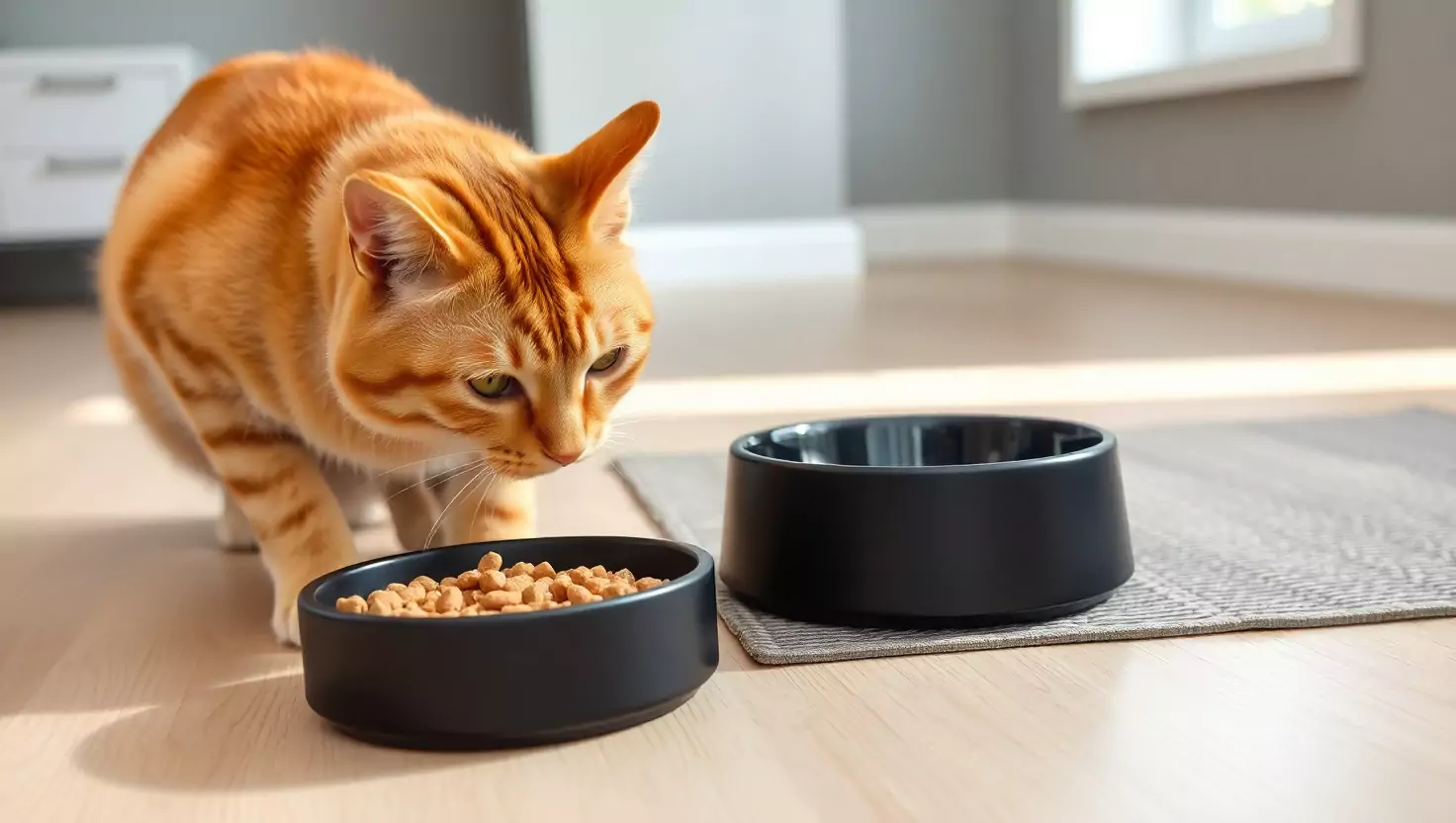
Senior Cat Diet and Meal Frequency (7+ Years)
As cats age, their dietary requirements will often change. Around age seven is when your cat becomes a senior, and this is when you may notice changes in your cat’s appetite, dental health, and digestion. Many senior cats benefit from wet or soft food, as it’s easier on aging teeth and includes moisture, which can help with hydration and prevent kidney disease or dehydration.
A senior prescription can support organ function, joint health, and lower calorie requirements, while still maintaining proper nutrition through the inclusion of essential nutrients, such as taurine, antioxidants, and omega-3 fatty acids.
Eat 2-3 smaller meals throughout the day to help ease your digestive system:
- Smaller, regular meals can help prevent vomiting, bloating, or the development of a food aversion
- Senior cats may eat less per sitting, and feeding them smaller meals regularly can help ensure they receive the necessary food
- If your older cat has chronic conditions, such as kidney disease, hyperthyroidism, or diabetes, consult your veterinarian to tailor their diet further to meet their specific needs
Suggested Schedule:
- 7:00 AM ( Wet food ½ daily portion)
- 12:00 PM (Light snack or treat (optional)
- 6:00 PM Wet food (remaining portion)
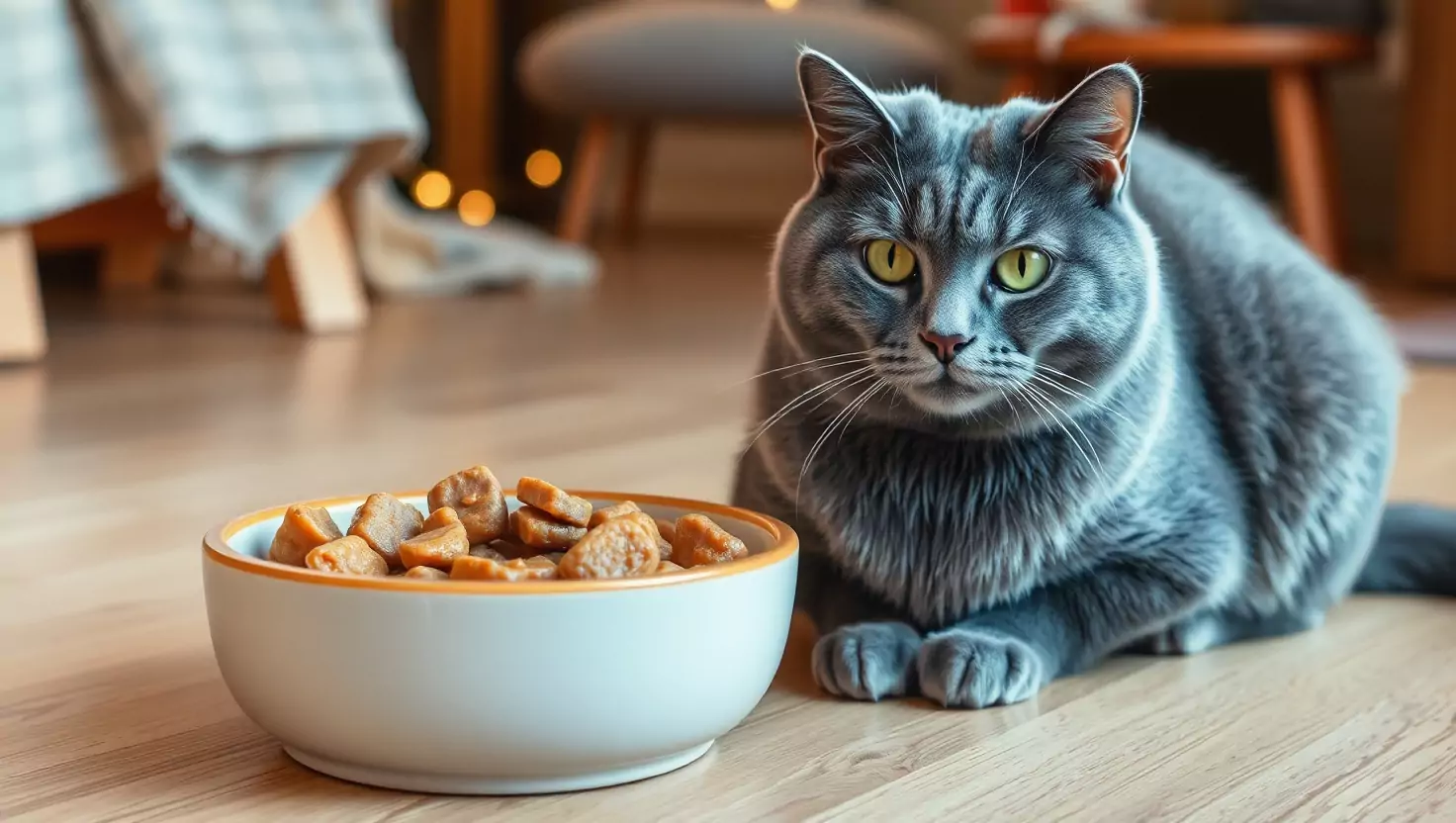
Busy Owner Schedule
If you are not home during the day, you can still maintain some structure in your pet’s feeding routine with the help of automation. Automated feeding can help ensure your cat doesn’t miss a meal, even if you are stuck in traffic.
Example Plan:
- 7:00 AM – wet food meal before you leave home
- 12:00 PM – device dispenses a set amount of dry food from the automatic feeder
- 6:00 PM – wet food dinner when you are home
Feeding the Right Number of Meals
Stick with a measured feeding routine instead of free feeding, especially with dry food. Use a measuring cup or digital scale for accuracy, and adjust servings as your cat’s weight or activity level changes. It is essential to feed your cat the appropriate number of meals and the right kind of food at every stage of life to give it the best chance for a long, healthy, and happy life.
Whether you have a frisky kitten that wants to explore, an adult cat that is curious and active, or are caring for an older, wiser kitty, considering a well-balanced feeding schedule can be significant.
If you are unsure about the amount of food your cat needs, this PetMD suggestion on how much to feed your cat is helpful.
Why a Regular Feeding Schedule Is Important
Feeding adult cats the same time every day has many health and behavioral benefits:
Metabolic Regulation
A cat’s body grows accustomed to a routine. Having scheduled meals allows their digestive system to prepare for that expected intake of food, which enhances nutrient absorption and utilization of energy.
Decreased Anxiety & Begging Behavior
Cats enjoy predictability. When they know ahead of time that they can expect to eat at a particular time, it allows them to feel safer, with fewer tendencies to beg, meow excessively, or paw at their food bowls, asking to eat.
Aids in Early Detection of Health Issues
Suppose your cat eats typically every meal and suddenly skips one. In that case, it may be a sign of dental issues, digestive problems, or, more concerning, a health issue that requires veterinary attention. Scheduled feeding allows for these changes to be detected more easily.
Portion Control is Key
Providing the right amount of food is equally important as providing food at the right time. Adult cats do not require as many calories as kittens; portion size should be based on their weight, physical activity level, and overall health.
Indoor/less active cats:
- Less calories
- Likelihood of weight gain if overfed.
- May need to evaluate diet and possibly provide a lower-calorie method
Outdoor/highly active cats:
- Burn more energy throughout the day
- May need a slightly larger portion size to maintain body condition
- Often do better with higher protein diets
Ask your veterinarian for personalized calorie recommendations or review the feeding guidelines on the cat food label and adjust the amount accordingly to meet your individual cat’s needs.
What Happens If You Overfeed Your Cat?
Overfeeding a cat, even with the best of intentions, can quietly set your cat up for significant health problems. While wild cats hunt their food and eat according to hunger and energy exertion, domestic cats depend entirely on us for food. When we offer food too often or provide too much, the result can be detrimental, harmful, and long-lasting.
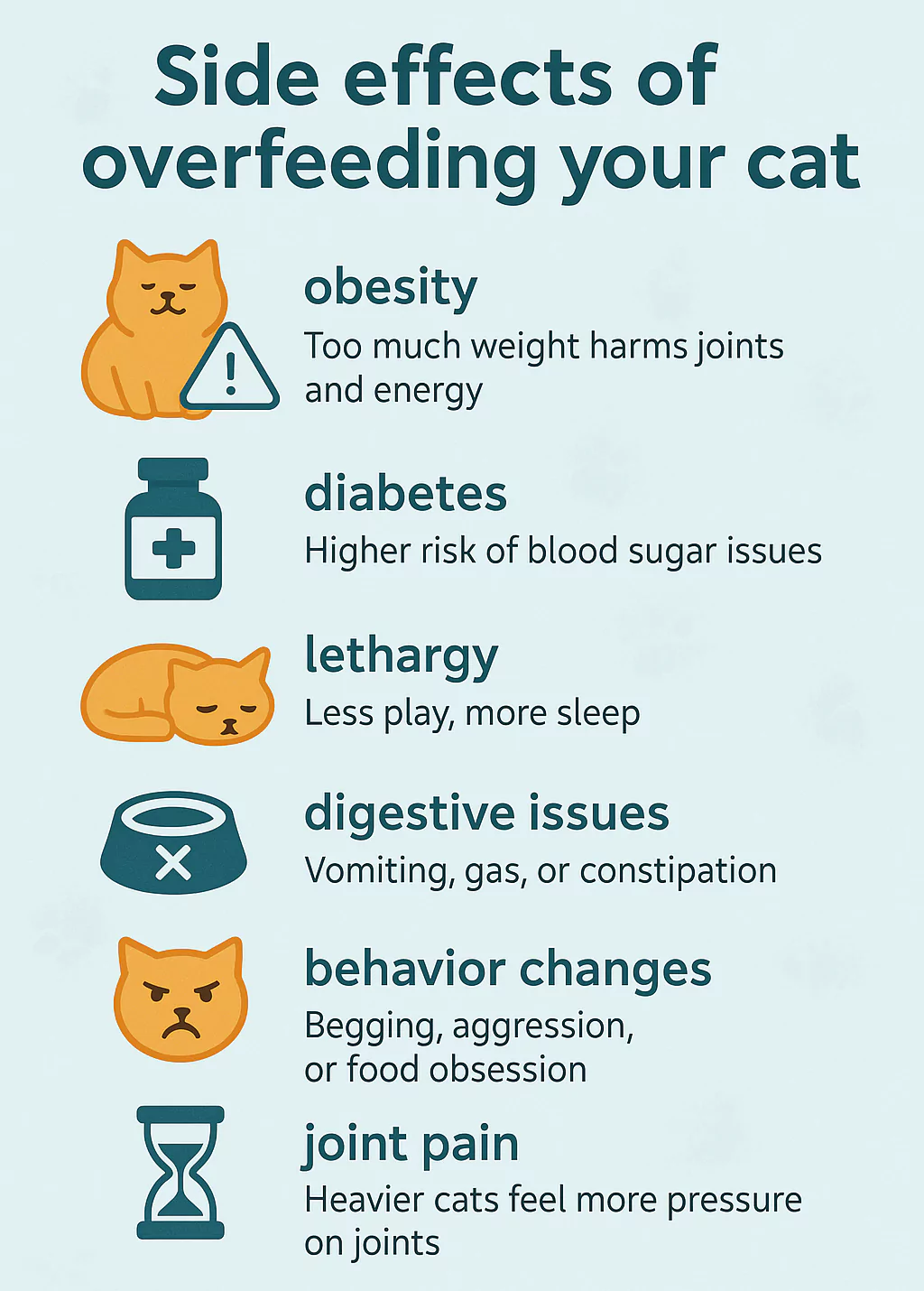
Obesity
One of the most apparent effects of overfeeding is excess weight gain. Obesity is not just a fluffy cat; it exposes your cat to a variety of chronic conditions. It may also shorten your cat’s life span and its quality of life.
Did you know? More than 50% of domestic cats are overweight or obese. And this problem often begins with harmless patterns of overfeeding.
To learn more about how feeds relate to your cat’s weight and health, take a look at this guide on pet obesity prevention.
Diabetes Mellitus
Obesity is a leading risk factor for type 2 diabetes in cats. Feline diabetes affects your cat’s ability to regulate blood sugar. It is also a disease that usually requires lifelong insulin treatment. Diabetes can also result in increased thirst, excessive urination, and weight loss despite normal or increased eating.
Joint Pain and Arthritis
Extra weight puts stress on your cat’s joints, especially as your cat ages. Obesity can cause or worsen arthritis. This painful condition can cause mobility issues, make jumping difficult, and reduce a cat’s activity level, creating a cyclical relationship of inactivity and weight gain.
Lethargy and Low Energy
Cats that are overweight tend to get lazy and stop playing and exploring. You might find them lying around more or grooming excessively. This lack of physical activity can also lead to diminished mental stimulation and emotional health.
Other Health Risks
Overly fed cats are at greater risk for:
- urinary tract disease
- heart disease
- respiratory difficulty due to excess body fat
- fatty liver disease (hepatic lipidosis) if they stop eating promptly.
Feeding needs change with age and health, so it is worthwhile to review how often your cat needs to visit the vet to receive regular updates.
Precision Matters
Instead of “eyeballing” your cat’s food, use a measuring cup or digital scale to ensure correct portioning of your cat’s meals. Follow your veterinarian’s recommendations and feeding portion, based on your cat’s age, weight, activity level, and any existing medical conditions.
While overfeeding may seem like an act of love, it could lead to a lifetime of health issues. Providing your cat with a structured, portion-controlled feeding schedule is one of the simplest yet most effective ways to protect your cat’s health and increase their chances of living a longer, higher-quality life.
Wet vs. Dry Cat Food: What’s Better for Your Cat?
When creating a consistent feeding routine for your cat, the food you provide is one of the first factors to consider. Wet and dry food offer several distinct advantages, and understanding how they can impact feeding schedules can help you establish a healthier, more manageable feeding routine for your cat.
Hydration and the Benefits of Wet Food
Wet cat food contains approximately 70-80% moisture, making it an excellent option for promoting hydration, especially in cats that naturally don’t drink enough water. Because cats evolved from desert animals, they will often have a low thirst drive and use food as a source of water.
Offering wet food frequently can help your kitty avoid many common health issues, including urinary tract infections, kidney disease, and dehydration. It can be beneficial for older cats or any cat with pre-existing health conditions.
However, wet food is perishable and requires a specific feeding schedule. Once opened and served, it begins to spoil fairly rapidly at room temperature. You should discard wet food after about 20 to 30 minutes to minimize the risk of contamination and potential digestive issues.
Why Wet Food Supports Scheduled Feeding
Wet food is unable to sit out all day and, therefore, typically lends itself to more structured mealtimes. Cats that eat damp food are generally likely to establish regular habits and arrive at mealtime on time.
Schedule feeding helps pet parents:
- Track their cat’s appetite
- Establish a routine
- Quickly notice a change in eating behavior
If you prefer a more routine-based lifestyle or if your cat seems to prefer predictability, wet food can support scheduled eating patterns and help alleviate food-related stress.
Mixing Wet and Dry: The Best of Both Worlds
Many cat parents follow a hybrid feeding approach, combining both wet and dry food to strike a balance between the health benefits of each and provide their cat with a well-rounded diet. It means you can serve wet food during certain mealtime hours while offering a small amount of dry food throughout the day.
Sample Routine:
- Serve wet food in the morning (around 7 AM) and evening (around 6 PM)
- Leave dry food for daytime munching or for when you are not home for any length of time
Wet feeding provides a variety of food, which can keep your cat hydrated and happy, offer portion control, reduce exposure to extra food, make boredom eating less likely, and be beneficial for cats who enjoy different textures and flavors in their food.
Storage and Safety Tips
Understanding how to store both types of food properly is essential for your cat’s health:
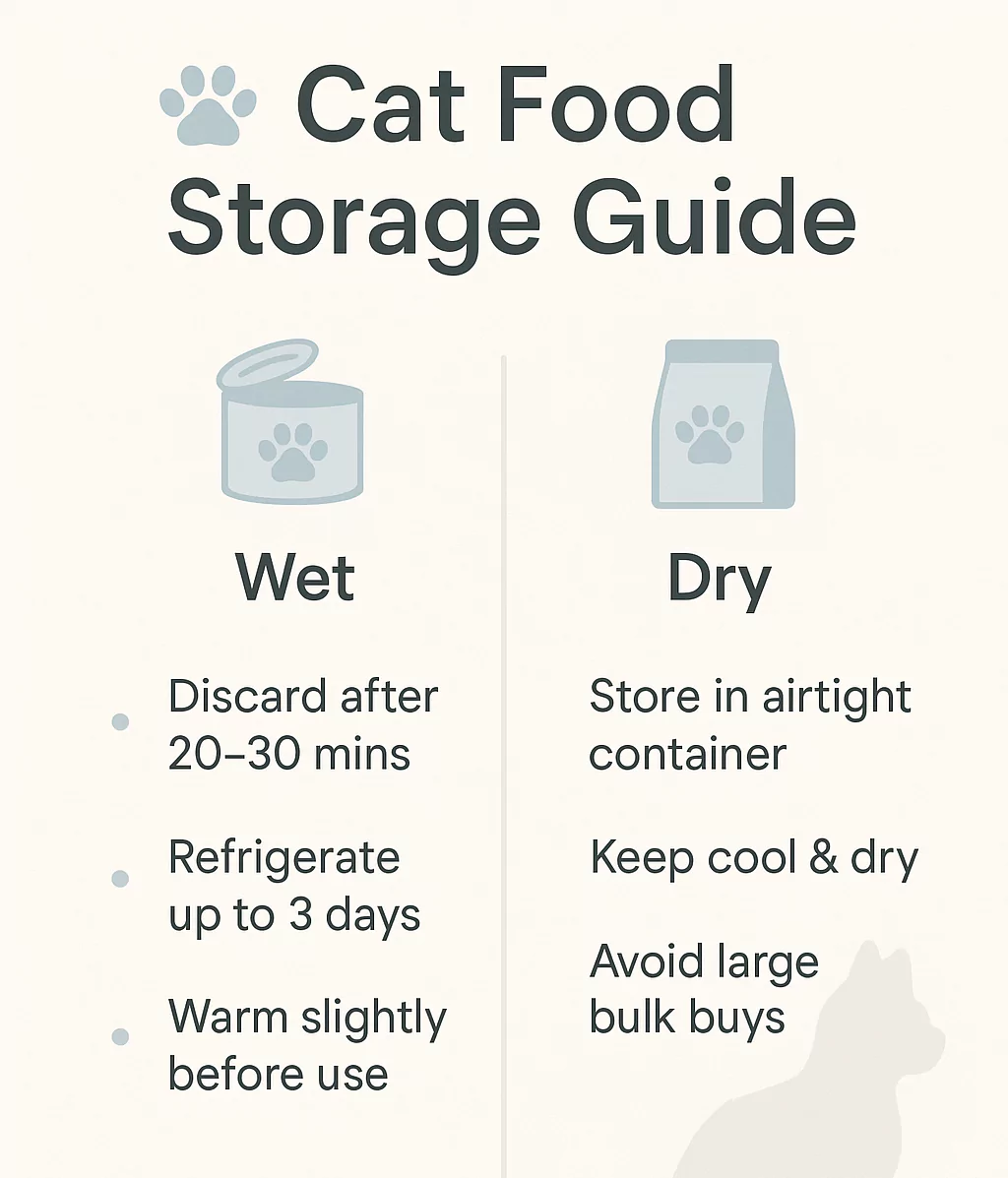
Suggested Food:
Both varieties of cat food (wet and dry) can be an essential part of a proper feeding plan. Wet food can provide hydration and a balanced meal structure, while dry food offers convenience and shelf-stable freshness. By blending both types of food, you can provide your cat with the appropriate nutrition and maintain a healthy routine.
Whether you choose to stick with one type of feeding schedule or choose a combination, the important thing is to be consistent with the time, portion size, and cleanliness. A good feeding schedule isn’t just about the food; it’s about creating an overall wellness plan for you and your pet that ensures peace of mind and reduces stress.
- If your goal is to have a regulated feeding schedule, wet food allows you to do that, because it must be served fresh. However, if you have a variable daily routine or are away during the day, dry food offers a convenient option.
- Using a combination of both foods is best, as it provides hydration, nutrition, convenience, and a routine that is beneficial for overall well-being.
Portion Sizes & Calorie Needs: How Much Should I Feed My Cat?
Understanding your cat’s optimal portion size ensures a proper nutritional and energy balance. Be as accurate as possible with your portion sizes by using a kitchen scale or measuring cup. Feed your cat at consistent times every day and regularly monitor their behavior and body condition cues.
A healthy feeding routine isn’t just about preventing weight problems; it also has positive effects on digestion, energy levels, and ultimately, a happier, healthier, and longer life.
Before establishing a healthy feeding routine, you’ll need to determine your cat’s calorie needs based on their weight, activity level, and health goals.
Average Calorie Needs for Cats
On average, adult cats need about 20-25 calories per pound of body weight daily to maintain a healthy weight. These are general guidelines; your cat may require more calories depending on its age, activity level, and whether it is spayed or neutered (neutered cats often have lower energy needs).
- A 5 lb cat needs around 100-125 calories/day
- A 10 lb cat (average adult weight) needs 200-250 calories/day
- A 15 lb cat may need 300-375 calories/day, depending on activity level
Weight-Based Feeding Chart
Always check the caloric amount on your cat’s food label. When measuring the portion, measure it according to the number of calories per serving. Below is a quick reference table to help determine how much you should feed your cat daily:
| Cat Weight | Daily Calories Needed | Meals Per day |
| 5 lbs | 100–125 kcal | 3 (smaller meals) |
| 10 lbs | 200–250 kcal | 2 (standard meals) |
| 15 lbs | 300–375 kcal | 2–3 (portion controlled) |
| 20lbs | 400-500 kcal/day | 3 meals |
Feeding for Weight Loss or Weight Gain
Just like people, cats may require individualized meal plans to achieve or maintain a healthy body weight. Being underweight or overweight can have negative impacts on a cat’s health and quality of life. Now, let us address how to properly feed a cat for weight gain and/or weight loss.
Feeding Cats for Weight Gain
- Add 10-15% to daily caloric intake.
- Increase the frequency of feeding to 3-4 meals a day.
- Feed high-protein, nutrient-dense foods (kitten or recovery foods).
- Heat food to increase appetite.
- Consult with a veterinarian to eliminate any potential health issues before changing a pet’s diet.
Underweight cats may suffer from:
- Recent illness or surgery
- Stress or anxiety
- Dental problems
- Parasites or absorption problems
- Aging and natural appetite decline
Goals:
- Safely increase body fat and muscle
- Support internal organ function
- Increase energy and vitality
- Ensure that no food or fatty scraps are left, as they could cause pancreatitis or digestive upset.
- Vet to rule out underlying health conditions (i.e., hyperthyroidism, worms, GI disease).
Feeding Cats for Weight Loss
- Reduce treats and high-calorie extras.
- Use slow feeders and puzzle bowls to slow their eating.
- Switch to a vet-approved low-calorie diet.
- Don’t cut calories too drastically; always follow your vet’s recommendations to avoid liver issues.
- Aim for slower weight loss (0.5 – 2% of body weight per week).
Overweight/obese cats may face complications such as:
- Diabetes
- Joint problems and arthritic issues
- Urinary tract issues
- Heart and respiratory stress
- Reduced life expectancy
Goals
- Safely reduce body fat
- Freely maintain lean muscle mass
- Encourage physical activity
Weight Management Tracking Table
| Metric | Weight Gain Focus | Weight Loss Focus |
| Calories/day | +10–15% above maintenance | -10–20% under vet supervision |
| Meals/day | 3 – 4 small meals | 2–3 controlled meals |
| Food Type | High-protein, high-fat | Low-calorie, high-protein |
| Vet Involvement | Strongly recommended | Required |
| Monitoring | Weekly weight check | Weekly weight check |
Tools to Automate and Improve Cat Feeding
Maintaining a consistent, healthy feeding schedule is crucial for your cat’s overall well-being, but it can be challenging to incorporate into a busy life. Fortunately, many innovative equipment and accessories can make feeding more efficient, enjoyable, and health-oriented for you and your cat.
Automatic Feeders: Smart Feeding with Precision
Automatic feeders are a game-changer in the world of modern pet care. They enable cat owners to provide accurate meal schedules when they are not at home. If you work long hours away from home, travel frequently, or have a cat on a strict feeding schedule (such as diabetic cats or overweight cats), an automatic feeder allows for meals to be fed on time and at the correct portion sizes.
Here are the following benefits of Automated feeders.
Portion Control
Automatic feeders dispense measured portions, preventing overfeeding while also monitoring calorie intake to maintain an appropriate weight.
Scheduled Feeding
You can program feeders to dispense meals at predetermined times for consistency with medication or medical conditions (diabetes).
Convenience
Great for busy or working pet parents, as it reduces the stress of rushing home to meet feeding time. Consider feeders that work with both dry and semi-moist food, as well as those that are easy to clean and maintain.
Some advanced feeders even offer
- Mobility control through an app
- Voice recordings to call your cat
- Multiple meal scheduling
Slow Feeders & Puzzle Bowls: Make Mealtime a Mental Game
Some cats tend to eat too fast, which can sometimes result in vomiting, choking, bloating, and poor digestion. Slow feeders and puzzle bowls enable slow eating while also engaging your cat’s natural predatory instincts. These tools are great, especially for indoor cats, who need an extra amount of stimulation throughout the day.
Here are some benefits of slow feeders & puzzle bowls:
Prohibits Gulping
Slow feeders offer cats a complex structure that encourages them to eat more slowly, thereby improving digestion and reducing the likelihood of regurgitation.
Mental Stimulation
Puzzle bowls help mimic the challenge of hunting or foraging, stimulating your cat’s brain and preventing boredom, especially for indoor cats that need mental stimulation.
Healthy Weight
Puzzle feeders enhance mealtime duration and discourage mindless eating, thereby helping to prevent obesity and alleviate food-related anxiety.
Best Feeding Stations to Reduce Whisker Fatigue
Cats have sensitive whiskers that can feel even the slightest change in air pressure. When those whiskers touch the sides of a deep or narrow food bowl, a cat can start to feel whisker fatigue, which can cause discomfort, anxiety, and even avoidance of food.
Wide, Shallow Bowls
These bowls allow your cat to eat comfortably without their whiskers touching the side of the bowl, providing a stress-free eating experience.
Elevated Stands
Elevating the bowl helps cats, especially senior cats or cats with arthritis or neck tightness, to eat in a more natural and comfortable position.
Stable and Non-Slip Base
A stable and non-slip base prevents the bowls from tipping or sliding while your cat is eating, providing an easy and mess-free experience. Stainless steel or ceramic bowls are the best option as they are hygienic, durable, and easy to clean.
Investing in the proper feeding tools, such as automatic feeders for consistency, puzzle bowls for enrichment, and whisker-friendly stations for comfort, can tremendously advance your cat’s health, happiness, and routine.
Final Tips for a Healthy Cat Feeding Schedule
Establishing a consistent and thoughtful feeding schedule is one of the best ways to support your cat’s overall well-being and happiness.
Here are some ways to achieve effective results:
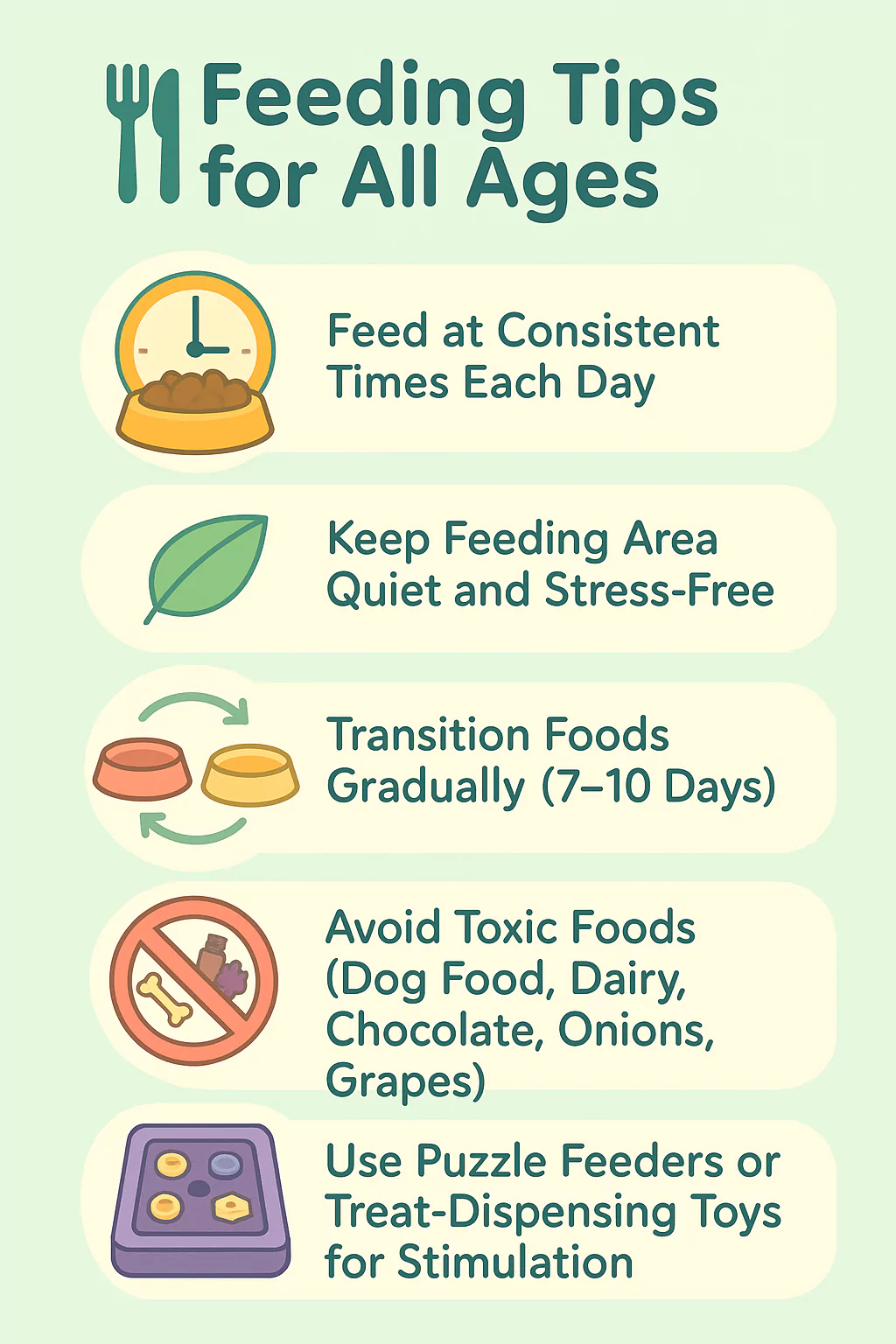
Stick to the Same Times Each Day
Cats are creatures of habit. Feeding your cat at the same time each day helps regulate their digestion, eases anxiety, and reduces begging for food. It will also make it easier to notice fluctuations in their appetite, which can often be an early indicator of health issues.
Adjust Portion Sizes Over Time
Over time, adjusting your cat’s portion sizes is crucial for maintaining a healthy weight and ensuring a proper balance of nutrition. Several factors can significantly impact your cat’s calorie needs, including age, activity level, and health.
Provide Clean Water at All Times
Hydration is just as important as food. Alongside clean water, knowing which cat-safe plants provide a safe, enriching environment can help maintain overall wellness.
Limit Treats
Treats should be no more than 10% of your cat’s daily caloric intake. Consuming too many treats can lead to weight gain and nutritional deficiencies.
Seek Your Veterinarian’s Guidance
Every cat is unique. Consult with your veterinarian if your cat has a medical condition or may have special dietary needs, or if you are just unsure how much to feed your cat.
For a general overview of cat care tips, see the ASPCA’s Cat Care guide, which covers feeding, grooming, and health needs.
FAQs
What is the best cat feeding schedule for kittens?
For kittens, the optimal feeding schedule is 3-4 small meals daily, using high-protein, nutrient-dense kitten food. Since kittens have speedy metabolisms, they require frequent meals to support proper growth. When you feed your kitten at the same time during the day, it can also help develop a healthy eating pattern.
How often should I feed my adult cat?
An adult cat’s eating schedule typically consists of two meals per day, one in the morning and another in the evening. Feeding cats on a regular schedule can help regulate their metabolism and prevent them from becoming overweight. Regular meal times will also aid digestion and support weight management.
Should I feed my senior cat differently?
Yes, a schedule for feeding senior cats could include smaller, more frequent meals made with easier-to-digest, lower-calorie food. Older cats often have slower metabolisms and may be prone to dental or kidney issues. Your adjustments will support their continued overall health and comfort.
Can I use automatic feeders to manage my cat’s feeding schedule?
Automatic feeders are an excellent option for ensuring consistent cat feeding, ensuring your cat gets fed on time every day, especially when you have a busy schedule. Feeders can precisely measure portions and time meals, making them ideal for cats that require scheduled meal times due to medical or weight loss needs. Some smart feeders have voice calling and even app control.
Conclusion
Establishing a proper feeding schedule for your cat is not just about routine; it is about health, happiness, and bonding. By learning about your cat’s age, lifestyle, and nutritional needs, you can create a tailored plan to ensure their health and happiness, and foster a strong bond with them at each stage of life.
By gradually adjusting the portion size over time, using the appropriate tools, and accurately evaluating your cat’s needs, you’re not just feeding them; you’re establishing a routine that promotes their well-being, prevents common health issues, and strengthens your bond. A feeding schedule is more than a routine; it’s an act of daily love.

